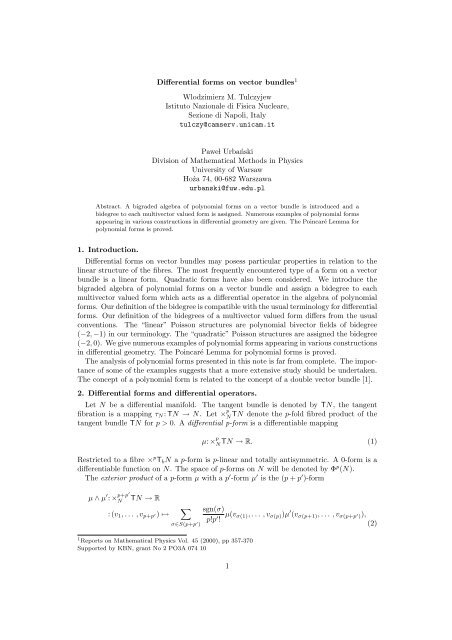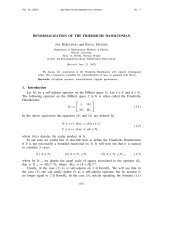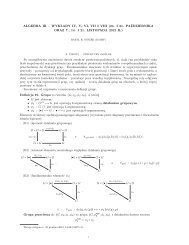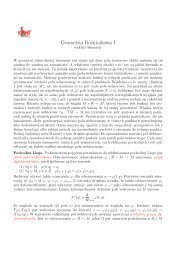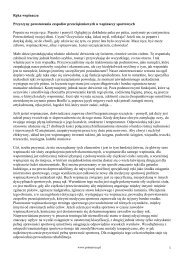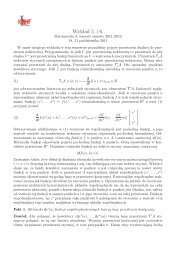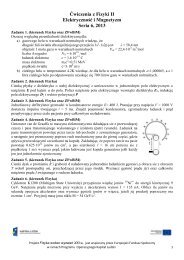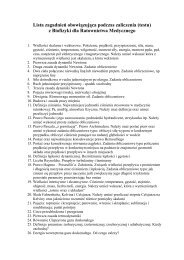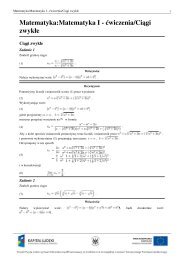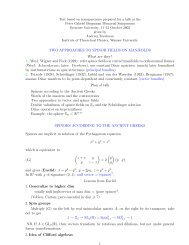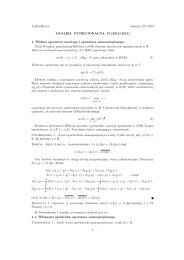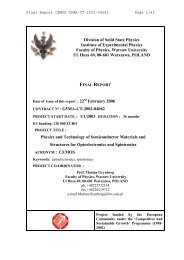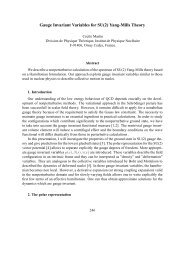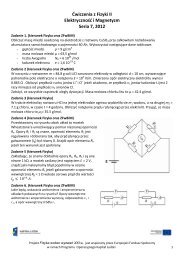Differential forms on vector bundles1 Wlodzimierz M. Tulczyjew ...
Differential forms on vector bundles1 Wlodzimierz M. Tulczyjew ...
Differential forms on vector bundles1 Wlodzimierz M. Tulczyjew ...
You also want an ePaper? Increase the reach of your titles
YUMPU automatically turns print PDFs into web optimized ePapers that Google loves.
<str<strong>on</strong>g>Differential</str<strong>on</strong>g> <str<strong>on</strong>g>forms</str<strong>on</strong>g> <strong>on</strong> <strong>vector</strong> bundles 1<br />
<strong>Wlodzimierz</strong> M. <strong>Tulczyjew</strong><br />
Istituto Nazi<strong>on</strong>ale di Fisica Nucleare,<br />
Sezi<strong>on</strong>e di Napoli, Italy<br />
tulczy@camserv.unicam.it<br />
Pawe̷l Urbański<br />
Divisi<strong>on</strong> of Mathematical Methods in Physics<br />
University of Warsaw<br />
Ho˙za 74, 00-682 Warszawa<br />
urbanski@fuw.edu.pl<br />
Abstract. A bigraded algebra of polynomial <str<strong>on</strong>g>forms</str<strong>on</strong>g> <strong>on</strong> a <strong>vector</strong> bundle is introduced and a<br />
bidegree to each multi<strong>vector</strong> valued form is assigned. Numerous examples of polynomial <str<strong>on</strong>g>forms</str<strong>on</strong>g><br />
appearing in various c<strong>on</strong>structi<strong>on</strong>s in differential geometry are given. The Poincaré Lemma for<br />
polynomial <str<strong>on</strong>g>forms</str<strong>on</strong>g> is proved.<br />
1. Introducti<strong>on</strong>.<br />
<str<strong>on</strong>g>Differential</str<strong>on</strong>g> <str<strong>on</strong>g>forms</str<strong>on</strong>g> <strong>on</strong> <strong>vector</strong> bundles may posess particular properties in relati<strong>on</strong> to the<br />
linear structure of the fibres. The most frequently encountered type of a form <strong>on</strong> a <strong>vector</strong><br />
bundle is a linear form. Quadratic <str<strong>on</strong>g>forms</str<strong>on</strong>g> have also been c<strong>on</strong>sidered. We introduce the<br />
bigraded algebra of polynomial <str<strong>on</strong>g>forms</str<strong>on</strong>g> <strong>on</strong> a <strong>vector</strong> bundle and assign a bidegree to each<br />
multi<strong>vector</strong> valued form which acts as a differential operator in the algebra of polynomial<br />
<str<strong>on</strong>g>forms</str<strong>on</strong>g>. Our definiti<strong>on</strong> of the bidegree is compatible with the usual terminology for differential<br />
<str<strong>on</strong>g>forms</str<strong>on</strong>g>. Our definiti<strong>on</strong> of the bidegrees of a multi<strong>vector</strong> valued form differs from the usual<br />
c<strong>on</strong>venti<strong>on</strong>s. The “linear” Poiss<strong>on</strong> structures are polynomial bi<strong>vector</strong> fields of bidegree<br />
(−2, −1) in our terminology. The “quadratic” Poiss<strong>on</strong> structures are assigned the bidegree<br />
(−2, 0). We give numerous examples of polynomial <str<strong>on</strong>g>forms</str<strong>on</strong>g> appearing in various c<strong>on</strong>structi<strong>on</strong>s<br />
in differential geometry. The Poincaré Lemma for polynomial <str<strong>on</strong>g>forms</str<strong>on</strong>g> is proved.<br />
The analysis of polynomial <str<strong>on</strong>g>forms</str<strong>on</strong>g> presented in this note is far from complete. The importance<br />
of some of the examples suggests that a more extensive study should be undertaken.<br />
The c<strong>on</strong>cept of a polynomial form is related to the c<strong>on</strong>cept of a double <strong>vector</strong> bundle [1].<br />
2. <str<strong>on</strong>g>Differential</str<strong>on</strong>g> <str<strong>on</strong>g>forms</str<strong>on</strong>g> and differential operators.<br />
Let N be a differential manifold. The tangent bundle is denoted by TN, the tangent<br />
fibrati<strong>on</strong> is a mapping τN : TN → N. Let × p<br />
NTN denote the p-fold fibred product of the<br />
tangent bundle TN for p > 0. A differential p-form is a differentiable mapping<br />
µ: × p<br />
NTN → R. (1)<br />
Restricted to a fibre × p TbN a p-form is p-linear and totally antisymmetric. A 0-form is a<br />
differentiable functi<strong>on</strong> <strong>on</strong> N. The space of p-<str<strong>on</strong>g>forms</str<strong>on</strong>g> <strong>on</strong> N will be denoted by Φ p (N).<br />
The exterior product of a p-form µ with a p ′ -form µ ′ is the (p + p ′ )-form<br />
µ ∧ µ ′ : × p+p′<br />
N TN → R<br />
: (v1, . . . , vp+p ′) ↦→<br />
<br />
σ∈S(p+p ′ )<br />
1 Reports <strong>on</strong> Mathematical Physics Vol. 45 (2000), pp 357-370<br />
Supported by KBN, grant No 2 PO3A 074 10<br />
sgn(σ)<br />
p!p ′ ! µ(v σ(1), . . . , v σ(p))µ ′ (v σ(p+1), . . . , v σ(p+p ′ )),<br />
(2)<br />
1
where S(p + p ′ ) denotes the group of permutati<strong>on</strong>s of the set {1, . . . , p + p ′ } of integers.<br />
The product of a functi<strong>on</strong> f <strong>on</strong> N with a p-form µ is the p-form<br />
fµ: × p<br />
N TN → R<br />
: (v1, . . . , vp) ↦→ f(τN (v1))µ(v1, . . . , vp)). (3)<br />
This product makes the space Φp (N) a module over the algebra Φ0 (N) of differentiable<br />
functi<strong>on</strong>s. The exterior product f ∧ µ of a 0-form f with a p-form µ is identified with the<br />
product fµ.<br />
The tangent <strong>vector</strong> of a curve γ: R → N will be denoted by tγ(0). It is well known that<br />
for each (v1, . . . , vp+1) ∈ × p+1<br />
N TN there is a differentiable mapping χ: Rp+1 → N such that<br />
vi = tγi(0), where γi is the curve<br />
γi: R → N<br />
for i = 1, . . . , p + 1. We introduce mappings<br />
and curves<br />
χi,j: R 2 → N<br />
: s ↦→ χ(δ 1 is, . . . , δ p+1 is) (4)<br />
: (s, t) ↦→ χ(δ 1 is + δ 1 jt, . . . , δ p+1 is + δ p+1 jt) (5)<br />
ρi,j: R → TN<br />
: s ↦→ tχi,j(s, ·)(0) (6)<br />
for i = 1, . . . , p + 1 and j = 1, . . . , p + 1. The exterior differential of a p-form is the<br />
(p + 1)-form<br />
dµ: × p+1<br />
N TN → R<br />
p+1<br />
i+1 d<br />
: (v1, . . . , vp+1) ↦→ (−1)<br />
ds µ(ρi,1(s), . . . , <br />
<br />
<br />
<br />
ρi,i(s), . . . , ρi,p+1(s)) <br />
i=1<br />
The differential of a 0-form f: N → R is the 1-form<br />
The space<br />
df: TN → R<br />
: tγ(0) ↦→ d<br />
ds f(γ(s))<br />
<br />
<br />
<br />
s=0<br />
s=0<br />
. (7)<br />
. (8)<br />
Φ(N) = ⊕ ∞ p=0Φ p (N) (9)<br />
with the exterior product ∧ and the exterior differential d is a differential graded algebra.<br />
Let (yi ): V → Rn be a local chart of N. At each b ∈ V there is a base of TbN composed of<br />
<strong>vector</strong>s ∂j(b) = tγj,b(0), with curves γj,b: R → N characterized by (yi ◦γj,b)(s) = yi (b)+δ i js<br />
for s sufficiently close to 0. The base (∂j(b)) is dual to the base (dyi (b)) of T∗ b N. We have<br />
where µi1...ip are the functi<strong>on</strong>s<br />
µ|V = 1<br />
p! µi1...ip dyi1 ∧ . . . ∧ dy ip , (10)<br />
µi1...ip: V → R<br />
: b ↦→ µ(∂i1(b), . . . , ∂ip(b)). (11)<br />
2
Following Claudette Buttin [2] we associate with each k-<strong>vector</strong> valued (k + q)-form<br />
a differential operator<br />
of degree q defined for a p-form µ with p k by<br />
iXµ(v1, . . . , vp+q)<br />
= <br />
σ∈S(p+q)<br />
X: × k+q<br />
N TN → ∧k TN (12)<br />
iX: Φ(N) → Φ(N) (13)<br />
sgn(σ)<br />
(k + q)!(p − k)! µ(X(v σ(1), . . . , v σ(k+q)), v σ(k+q+1), . . . , v σ(p+q)) (14)<br />
with some abuse of notati<strong>on</strong>. If µ is a differential form of degree p < k, then iXµ = 0. A<br />
differential operator<br />
dX: Φ(N) → Φ(N) (15)<br />
of degree q + 1 is defined by<br />
dX = [iX, d] = iXd + (−1) q+1 diX. (16)<br />
These definiti<strong>on</strong>s include special cases of operators associated with differential <str<strong>on</strong>g>forms</str<strong>on</strong>g> (k = 0)<br />
and with multi<strong>vector</strong> fields (k + q = 0). The exterior differential d is a special case of an<br />
operator of degree 1.<br />
In terms of a local chart (y i ): V → R n of N we have the representati<strong>on</strong><br />
X|V =<br />
1<br />
k!(k + q)! Xi1...ik+q<br />
j1...jk i1 ik+q (dy ∧ . . . ∧ dy ) ⊗ (∂j1 ∧ . . . ∧ ∂jk ) (17)<br />
j1...jk of a k-<strong>vector</strong> valued (k + q)-form X with functi<strong>on</strong>s Xi1...ik+q defined by<br />
j1...jk<br />
Xi1...ik+q : V → R<br />
: b ↦→ 〈dy j1 jk (b) ∧ . . . ∧ dy (b), X(∂i1(b), . . . , ∂ik+q (b))〉. (18)<br />
3. The algebra of polynomial functi<strong>on</strong>s <strong>on</strong> a <strong>vector</strong> bundle.<br />
Let ϕ: F → N be a <strong>vector</strong> fibrati<strong>on</strong>. We denote by Φ 0 (F ) the algebra of differentiable<br />
functi<strong>on</strong>s <strong>on</strong> F . We denote by Π (0,0) (ϕ) the subalgebra of the algebra Φ 0 (F ) composed<br />
of mappings c<strong>on</strong>stant <strong>on</strong> fibres of ϕ. Each element of Π (0,0) (ϕ) is the pullback f ◦ ϕ of a<br />
differentiable functi<strong>on</strong> f: N → R. We denote by Π (0,1) (ϕ) the space of functi<strong>on</strong>s linear <strong>on</strong><br />
fibres of ϕ. A power (Π (0,1) (ϕ)) r of the space Π (0,1) (ϕ) will be denoted by Π (0,r) (ϕ) for<br />
each r 0. The graded algebra<br />
Π (0,∗) (ϕ) = + ∞ r=0Π (0,r) (ϕ) (19)<br />
will be called the algebra of polynomial functi<strong>on</strong>s <strong>on</strong> the bundle F .<br />
4. Polynomial <str<strong>on</strong>g>forms</str<strong>on</strong>g> <strong>on</strong> a <strong>vector</strong> bundle.<br />
Let ε: E → M be a <strong>vector</strong> fibrati<strong>on</strong>. The tangent fibrati<strong>on</strong> Tε: TE → TM is a <strong>vector</strong><br />
fibrati<strong>on</strong>. We have operati<strong>on</strong>s<br />
· ′ : R × TE → TE<br />
: (λ, tγ(0)) ↦→ t(λγ)(0) (20)<br />
3
and<br />
+ ′ : TE ×TM TE → TE<br />
: (tγ(0), tγ ′ (0)) ↦→ t(γ + γ ′ )(0), (21)<br />
where γ: R → E and γ ′ : R → E are differentiable curves such that ε ◦ γ ′ = ε ◦ γ and the<br />
symbols tγ(0) and tγ ′ (0) denote the tangent <strong>vector</strong>s of the curves γ and γ ′ . Relati<strong>on</strong>s<br />
follow directly from the definiti<strong>on</strong>s.<br />
Tε be the mapping<br />
Let × p<br />
M,E<br />
τE(λ · ′ v) = λτE(v), (22)<br />
τE(v + ′ v ′ ) = τE(v) + τE(v ′ ), (23)<br />
Tε(λ · ′ v) = Tε(v), (24)<br />
Tε(v + ′ v ′ ) = Tε(v) = Tε(v ′ ) (25)<br />
× p<br />
M,ETε: ×p<br />
ETE → ×p<br />
M TM<br />
: (v1, . . . , vp) ↦→ (Tε(v1), . . . , Tε(vp)). (26)<br />
This mapping is again a <strong>vector</strong> fibrati<strong>on</strong> with operati<strong>on</strong>s<br />
and<br />
The space<br />
· p : R × (× p<br />
ETE) → ×p<br />
ETE : (λ, (v1, . . . , vp)) ↦→ (λ · ′ v1, . . . , λ · ′ vp) (27)<br />
+ p : (× p<br />
ETE) × × p<br />
M TM (× p<br />
ETE) → ×p<br />
ETE : ((v1, . . . , vp), (v ′ 1, . . . , v ′ p)) ↦→ (v1 + ′ v1, . . . , vp + ′ v ′ p). (28)<br />
Π (p,r) (ε) = Π (0,r) (× p<br />
M,E Tε) ∩ Φp (E) (29)<br />
will be called the space of polynomial <str<strong>on</strong>g>forms</str<strong>on</strong>g> <strong>on</strong> E of bidegree (p, r).<br />
It is easily seen from formulae (2) and (3) that the exterior product µ ∧ µ ′ of polynomial<br />
<str<strong>on</strong>g>forms</str<strong>on</strong>g> µ and µ ′ of bidegrees (p, r) and (p ′ , r ′ ) respectively is a polynomial form of bidegree<br />
(p + p ′ , r + r ′ ). It follows from formulae (7) and (8) that the exterior differential dµ of a<br />
polynomial form µ of bidegree (p, r) is a polynomial form of bidegree (p + 1, r). It follows<br />
that<br />
Π(ε) = ⊕ ∞ p=0 + ∞ r=0 Π (p,r) (ε) (30)<br />
is a subalgebra of the differential graded algebra Φ(E). This algebra will be called the<br />
bigraded differential algebra of polynomial <str<strong>on</strong>g>forms</str<strong>on</strong>g> <strong>on</strong> E<br />
If<br />
F<br />
ϕ<br />
<br />
α<br />
<br />
E<br />
ε<br />
<br />
M M<br />
is a <strong>vector</strong> fibrati<strong>on</strong> morphism and µ is a polynomial form <strong>on</strong> E of bidegree (p, k), then α ∗ µ<br />
is a polynomial form <strong>on</strong> F of the same bidegree (p, k).<br />
4<br />
(31)
Let (x κ ): U ⊂ M → R m be a local chart of M and let (x κ , e A ): ε −1 (U) ⊂ E → R m+k be<br />
an adapted chart of E. A p-form µ <strong>on</strong> E is locally represented by<br />
µ|ε −1 (U) = <br />
p ′ +p ′′ =p<br />
with the functi<strong>on</strong>s µκ1...κ p ′ A1...A p ′′ defined by<br />
1<br />
p ′ !p ′′ ! µκ1...κ p ′ A1...A p ′′ dx κ1 ∧ . . . ∧ dx κ p ′ ∧ de A1 ∧ . . . ∧ de A p ′′ (32)<br />
µκ1...κ p ′ A1...A p ′′ : ε −1 (U) → R<br />
: e ↦→ µ(∂κ1(e), . . . , ∂κ p ′ (e), ∂A1(e), . . . , ∂A p ′′ (e)). (33)<br />
The coordinates x κ are functi<strong>on</strong>s c<strong>on</strong>stant <strong>on</strong> fibres of ε and coordinates e A are linear. If µ<br />
is a polynomial form of bidegree (p, r), then each functi<strong>on</strong> µκ1...κ p ′ A1...A p ′′ is a polynomial<br />
form of bidegree (0, r − p ′′ ).<br />
A polynomial differential operator is a differential operator of the algebra Φ(M) which can<br />
be restricted to the subalgebra Π(ε). A polynomial operator K is said to be of bidegree (q, s)<br />
if µ ∈ Π (p,r) (ε) implies Kµ ∈ Π (p+q,r+s) (ε). A multi<strong>vector</strong> valued differential form X is<br />
said to be a polynomial form of bidegree (q, s) if the differential operator iX is a polynomial<br />
operator of bidegree (q, s). If a differential form µ is a polynomial form of bidegree (p, r), it<br />
is a polynomial 0-<strong>vector</strong> valued form of the same bidegree (p, r).<br />
Let (x κ , e A ): ε −1 (U) ⊂ E → R m+k be an adapted chart of E. A k-<strong>vector</strong> valued (k + q)form<br />
is locally represented by<br />
X|ε −1 (U) =<br />
<br />
<br />
q ′ +q ′′ =k+q k ′ +k ′′ 1<br />
q<br />
=k<br />
′ !q ′′ !k ′ !k ′′ ! Xκ1...κ<br />
λ1...λk ′ B1...Bk ′′<br />
q ′ A1...Aq ′′<br />
κ1 κ<br />
dx ∧ . . . ∧ dx q ′ A1 A<br />
∧ de ∧ . . . ∧ de q ′′ ⊗ ∂λ1 ∧ . . . ∧ ∂λk ′ ∧ ∂B1 ∧ . . . ∂Bk ′′<br />
λ1...λ with the functi<strong>on</strong>s Xκ1...κ<br />
k ′ B1...Bk ′′<br />
q ′ A1...Aq ′′<br />
defined by<br />
λ1...λ<br />
Xκ1...κ<br />
k ′ B1...Bk ′′<br />
q ′ A1...Aq ′′<br />
(e)<br />
= 〈dx λ1 ∧ . . . ∧ dx λ q ′ ∧ de B1 ∧ . . . ∧ de B q ′′ , X(∂κ1(e), . . . , ∂κ p ′ (e), ∂A1(e), . . . , ∂A p ′′ (e))〉.<br />
(35)<br />
λ1...λ If X is a polynomial form of bidegree (q, s), then each functi<strong>on</strong> Xκ1...κ<br />
k ′ B1...Bk ′′<br />
q ′ A1...Aq ′′<br />
is a polynomial form of bidegree (0, r − q ′′ + k ′′ ).<br />
5. Examples.<br />
Let ε: E → M be a <strong>vector</strong> fibrati<strong>on</strong>. We introduce the mapping<br />
where γ is the curve<br />
χ(ε): E ×M E → TE<br />
<br />
(34)<br />
: (e, e ′ ) ↦→ tγ(0), (36)<br />
γ: R → E<br />
The image of χ(ε) is the subbundle of vertical <strong>vector</strong>s<br />
of the tangent bundle TE.<br />
: s ↦→ e + se ′ . (37)<br />
VE = {v ∈ TE; Tε(v) = 0} (38)<br />
5
The Liouville field <strong>on</strong> E is the <strong>vector</strong> field<br />
L(ε): E → TE<br />
: e ↦→ χ(e, e). (39)<br />
The Liouville field is a <strong>vector</strong> field of bidegree (−1, 0). The flow of the Liouville field is the<br />
mapping<br />
λ(ε): R × E → E<br />
: (s, e) ↦→ exp(s)e. (40)<br />
Let σ: M → E be a secti<strong>on</strong> of a <strong>vector</strong> fibrati<strong>on</strong> ε: E → M. We define a<br />
<strong>vector</strong> field<br />
The flow of the field S is the mapping<br />
S: E → TE<br />
: e ↦→ χ(e, σ(ε(e))). (41)<br />
σ: R × E → E<br />
: (s, e) ↦→ e + sσ(ε(e)). (42)<br />
The field S is a polynomial field of bidegree (−1, −1).<br />
Let ε: E → M be a <strong>vector</strong> fibrati<strong>on</strong>. A c<strong>on</strong>necti<strong>on</strong> <strong>on</strong> the fibrati<strong>on</strong> is <strong>vector</strong><br />
valued 1-form H: TE → TE such that H ◦ H = H and the image of H is the vertical<br />
subbundle VE ⊂ TE. The c<strong>on</strong>necti<strong>on</strong> is said to be linear if H is a polynomial <strong>vector</strong> valued<br />
form of bidegree (0, 0).<br />
Let M be a differential manifold. The pull back τ∗ M µ of a p-form µ ∈ Φ(M)<br />
is the p-form<br />
τ ∗ M µ: × p<br />
TM TTM → R<br />
: (w1, . . . , wp) ↦→ µ(TτM (w1), . . . , TτM (wp)). (43)<br />
A derivati<strong>on</strong> iT : Φ(M) → Φ(TM) relative to the pull back m<strong>on</strong>omorphism τ∗ M : Φ(M) →<br />
Φ(TM) [3] is defined by<br />
iT µ: × p<br />
TM TTM → R<br />
: (w1, . . . , wp) ↦→ µ(τTM (w1), TτM (w1), . . . , TτM (wp)) (44)<br />
for a (p + 1)-form µ. Relati<strong>on</strong>s (22)–(25) with ε: E → M replaced by τM : TM → M<br />
imply that if µ ∈ Φ p (M), then τ ∗ M µ ∈ Π(p,0) (TM) and iT µ ∈ Π (p−1,1) (τM ). A derivati<strong>on</strong><br />
dT : Φ(M) → Φ(TM) relative to the tangent projecti<strong>on</strong> τM is defined by dT = iT d + diT . If<br />
µ ∈ Φ p (M), then dT µ ∈ Π (p,1) (τM ).<br />
If the algebra Φ(M) is interpreted as a trivial case<br />
Π(idM ) = ⊕ ∞ p=0Π(p, 0)(idM ) (45)<br />
of an algebra of polynomial <str<strong>on</strong>g>forms</str<strong>on</strong>g>, then the pull back m<strong>on</strong>omorphisms is of bidegree (0, 0)<br />
and the derivati<strong>on</strong>s iT and dT ore of bidegrees (−1, 1) and (0, 1) respectively.<br />
6
Let X: M → TM be a <strong>vector</strong> field. Let<br />
κM : TTM → TTM. (46)<br />
be the can<strong>on</strong>ical involuti<strong>on</strong> appearing in the <strong>vector</strong> fibrati<strong>on</strong> isomorphism<br />
TτM<br />
TTM<br />
<br />
κM<br />
<br />
TTM<br />
τTM<br />
TM TM<br />
<br />
. (47)<br />
The mapping dT X = κM ◦ TX: TM → TTM is a <strong>vector</strong> field <strong>on</strong> TM. It is the tangent lift<br />
of X. The tangent lift is a polynomial field of bidegree (−1, 0).<br />
Let M be a differential manifold. The Liouville 1-form <strong>on</strong> T ∗ M is the<br />
mapping<br />
ϑM : TT ∗ M → R<br />
: w ↦→ 〈τ T∗ M (w), TπM (w)〉. (48)<br />
Relati<strong>on</strong>s (22)–(25) with ε: E → M replaced by the cotangent projecti<strong>on</strong> πM : T ∗ M → M<br />
imply that ϑM is of bidegree (1, 1). C<strong>on</strong>sequently the symplectic form ωM = dϑM is of<br />
bidegree (2, 1) and the Poiss<strong>on</strong> bi<strong>vector</strong> field Λ is of bidegree (−2, −1).<br />
Let X: M → TM be a <strong>vector</strong> field. The functi<strong>on</strong><br />
X: T ∗ M → R<br />
: p ↦→ 〈p, X(πM (p))〉 (49)<br />
is form of bidegree (0, 1). C<strong>on</strong>sequently the Hamilt<strong>on</strong>ian <strong>vector</strong> field Y <strong>on</strong> T ∗ M defined by<br />
is of bidegree (−1, 0). The field Y is the can<strong>on</strong>ical lift of X.<br />
iY dϑM = −d X (50)<br />
Let X: × q<br />
M TM → TM be a <strong>vector</strong> valued differential form. The q-form<br />
X: × q<br />
T∗ M TT ∗ M → R<br />
: (w1, . . . , wq) ↦→ 〈τ T∗ M (w1), X(TπM (w1), . . . , TπM (wq))〉 (51)<br />
is of bidegree (q, 1). The equati<strong>on</strong><br />
iY dϑM = −d X (52)<br />
defines a <strong>vector</strong> valued q-form <strong>on</strong> T ∗ M of bidegree (q − 1, 0). The <strong>vector</strong> valued form Y<br />
can be c<strong>on</strong>sidered the can<strong>on</strong>ical lift of X.<br />
Let ε: E → M be a <strong>vector</strong> fibrati<strong>on</strong> and let Λ be a Poiss<strong>on</strong> bi<strong>vector</strong> field <strong>on</strong><br />
E. If Λ is a polynomial field of bidegree (−2, −1), then the associated Poiss<strong>on</strong> bracket<br />
is usually said to be linear [4].<br />
{ , }Λ: Φ 0 (E) × Φ 0 (E) → Φ 0 (E)<br />
: (f, g) ↦→ 〈df ∧ dg, Λ〉 (53)<br />
7
A polynomial Poiss<strong>on</strong> bi<strong>vector</strong> field Λ <strong>on</strong> E of bidegree (−2, −1) induces a Lie algebroid<br />
structure [5] <strong>on</strong> the dual fibrati<strong>on</strong> ˜ε: E ∗ → M. The space Π (0,0) (ε) is identified with the<br />
algebra Φ 0 (M) and the space Π (0,1) (ε) is identified with the module Γ(˜ε) of secti<strong>on</strong>s of the<br />
fibrati<strong>on</strong> ˜ε. With a functi<strong>on</strong> f ∈ Π (0,0) (ε) we associate a functi<strong>on</strong> ¯ f ∈ Φ 0 (M) such that<br />
f = ¯ f ◦ ε. With a functi<strong>on</strong> g ∈ Π (0,1) (ε) we associate a secti<strong>on</strong> ¯g: M → E ∗ such that<br />
〈 ¯ f(a), e〉 = f(e) for each a ∈ M and each e ∈ E such that ε(e) = a. If g ∈ Π (0,1) (ε) and<br />
h ∈ Π (0,1) (ε), then {g, h}Λ ∈ Π (0,1) (ε). A Lie bracket in Γ(˜ε) is defined by<br />
[ , ]: Γ(˜ε) × Γ(˜ε) → Γ(˜ε)<br />
: (¯g, ¯ h) ↦→ {g, h} Λ . (54)<br />
If f ∈ Π (0,0) (ε) and g ∈ Π (0,1) (ε), then {f, g}Λ ∈ Π (0,0) (ε). The anchor ρ: E ∗ → TM is<br />
characterized by<br />
〈d ¯ f(a), ρ(¯g(a))〉 = {f, g}Λ(a). (55)<br />
Let ε: E → M be a <strong>vector</strong> fibrati<strong>on</strong> and let µ be a (p + 1)-form <strong>on</strong> E. A<br />
<strong>vector</strong> fibrati<strong>on</strong> morphism<br />
is characterized by<br />
E<br />
ε<br />
<br />
˜µ<br />
<br />
∧ p T ∗ M<br />
π p<br />
M<br />
M M<br />
<br />
(56)<br />
〈v1 ∧ . . . ∧ vp, ˜µ(e)〉 = µ(χ(ε)(O(a), e)), TO(v1), . . . , TO(vp)), (57)<br />
where O: M → E denotes the zero secti<strong>on</strong> of ε and a = ε(e) = τM (v1) = . . . = τM (vp). Let<br />
ϑ p<br />
M be the Liouville p-form <strong>on</strong> ∧pT∗M and let ω p<br />
M = dϑp M be the can<strong>on</strong>ical (p + 1)-form <strong>on</strong><br />
∧pT∗M. For each <strong>vector</strong> fibrati<strong>on</strong> morphism<br />
the form ρ ∗ ω p<br />
M<br />
E<br />
ε<br />
<br />
ρ<br />
<br />
∧ p T ∗ M<br />
π p<br />
M<br />
M M<br />
is an exact polynomial form of bidegree (p + 1, 1). In particular the form<br />
˜µ ∗ω p<br />
M is an exact polynomial form of bidegree (p + 1, 1).<br />
Let µ be a polynomial form of bidegree (p + 1, 1) and let (xκ , eA ): ε−1 (U) ⊂ E → Rm+k be an adapted chart of E. The form µ is locally represented by<br />
µ|ε −1 (U) =<br />
1<br />
(p + 1)! µA;κ1...κp+1e A dx κ1 ∧ . . . ∧ dx κp+1<br />
with µA;κ1...κp+1 and µκ1...κpA in Π(0, 0)(ε).<br />
<br />
(58)<br />
+ 1<br />
p! µκ1...κpAdx κ1 ∧ . . . ∧ dx κp ∧ de A (59)<br />
Let (xκ , pκ1...κp): (π p<br />
M )−1 (U) → R m+(m p) p be an adapted local chart of ∧ T∗M. The<br />
mapping ˜µ defined above is locally characterized by<br />
pκ1...κp ◦ ˜µ = (−1) p µκ1...κpAe A . (60)<br />
8
The can<strong>on</strong>ical (p + 1)-form ω p<br />
M <strong>on</strong> ∧p T ∗ M is expressed locally by<br />
ω p<br />
M |(πp<br />
M )−1 (U) = 1<br />
p! dpκ1...κp ∧ dx κ1 ∧ . . . ∧ dx κp . (61)<br />
The local expressi<strong>on</strong> of the pull back ˜µ ∗ ω p<br />
M<br />
is the form<br />
˜µ ∗ ω p<br />
M |ε−1 (U) = 1<br />
p! µκ1...κpAdx κ1 ∧ . . . ∧ dx κp ∧ de A<br />
+ (−1)p<br />
p! ∂κµκ1...κpAe A dx κ ∧ dx κ1 ∧ . . . ∧ dx κp . (62)<br />
Using these local expressi<strong>on</strong>s it is easy to verify that the equality ˜µ ∗ ω p<br />
M<br />
<strong>on</strong>ly if dµ = 0. It is also clear that if µ = ρ∗ω p<br />
M , then ˜µ = ρ.<br />
If µ is a closed polynomial form <strong>on</strong> E of bidegree (p + 1, 1), then<br />
= µ holds if and<br />
µ = ˜µ ∗ ω p<br />
M = ˜µ∗ dϑ p<br />
M = d˜µ∗ ϑ p<br />
M . (63)<br />
It follows that the form µ is exact. The Liouville form is a polynomial form of bidegree<br />
(p, 1). Hence, the form ˜µ ∗ϑ p<br />
is a polynomial form of bidegree (p, 1). It follows that a<br />
M<br />
closed polynomial form <strong>on</strong> E of bidegree (p + 1, 1) is the differential of a polynomial form<br />
of bidegree (p, 1).<br />
We c<strong>on</strong>clude with the observati<strong>on</strong> that there is a <strong>on</strong>e to <strong>on</strong>e corresp<strong>on</strong>dence between<br />
closed (exact) polynomial <str<strong>on</strong>g>forms</str<strong>on</strong>g> <strong>on</strong> E of bidegree (p + 1, 1) and <strong>vector</strong> fibrati<strong>on</strong> morphisms<br />
(58).<br />
Let π: P → M be a <strong>vector</strong> fibrati<strong>on</strong> and let ω be a closed polynomial form<br />
of bidegree (2, 1) <strong>on</strong> P . Let β (P,ω): TP → T ∗ P be the mapping characterized by<br />
〈β (P,ω)(u), v〉 = ω(u, v) (64)<br />
for u and v in TP such that τP (v) = τP (u). The <strong>vector</strong> fibrati<strong>on</strong> morphism<br />
P<br />
˜ω<br />
π<br />
πM<br />
<br />
<br />
M M<br />
<br />
T ∗ M<br />
defined in the preceding example is an isomorphism if and <strong>on</strong>ly if ω is n<strong>on</strong>degenerate in the<br />
sense that the diagram<br />
τP<br />
TP<br />
<br />
β (P,ω)<br />
<br />
T ∗ P<br />
πP<br />
P P<br />
is a <strong>vector</strong> fibrati<strong>on</strong> isomorphism. The corresp<strong>on</strong>dence between closed n<strong>on</strong>degenerate polynomial<br />
<str<strong>on</strong>g>forms</str<strong>on</strong>g> of bidegree (2, 1) <strong>on</strong> P and <strong>vector</strong> fibrati<strong>on</strong> isomorphisms (65) is <strong>on</strong>e to <strong>on</strong>e.<br />
The closed n<strong>on</strong>degenerate polynomial form of bidegree (2, 1) <strong>on</strong> T∗M associated with the<br />
identity morphism<br />
T ∗ 1<br />
M<br />
T∗M T ∗ M<br />
πM<br />
<br />
<br />
πM<br />
M M<br />
9<br />
<br />
<br />
(65)<br />
(66)<br />
(67)
is the can<strong>on</strong>ical symplectic form ωM . This property can be used to characterize the can<strong>on</strong>ical<br />
form ωM .<br />
Let (P, ω) be a symplectic manifold. A <strong>vector</strong> fibrati<strong>on</strong> π: P → M is called a special<br />
symplectic structure for (P, ω) if ω is a polynomial form of bidegree (2, 1) <strong>on</strong> P in relati<strong>on</strong><br />
to this fibrati<strong>on</strong>. The objects ω and π establish a symplectomorphism between (P, ω)<br />
and (T ∗ M, ωM ). The c<strong>on</strong>cept of a special symplectic structure is useful for c<strong>on</strong>structing<br />
generating functi<strong>on</strong>s of Lagrangian submanifolds of (P, ω). Two important examples of<br />
special symplectic structures are known. The form dT ωM is a symplectic form <strong>on</strong> TT ∗ M.<br />
This form is a polynomial form of bidegree (2, 1) in relati<strong>on</strong> to the fibrati<strong>on</strong> τ T∗ M : TT ∗ M →<br />
T ∗ M and also in relati<strong>on</strong> to the fibrati<strong>on</strong> TπM : TT ∗ M → TM. C<strong>on</strong>sequently we have <strong>vector</strong><br />
fibrati<strong>on</strong> isomorphisms<br />
and<br />
TT ∗ M<br />
τ T∗ M<br />
<br />
β (T∗M,ωM ) T<br />
∗<br />
T<br />
∗<br />
M<br />
π T∗ M<br />
T ∗ M T ∗ M<br />
TT ∗ M<br />
TπM<br />
<br />
αM<br />
<br />
T ∗ TM<br />
πTM<br />
TM TM<br />
<br />
<br />
(68)<br />
. (69)<br />
The “quadratic” Poiss<strong>on</strong> structures classified by Xu [6] are polynomial<br />
bi<strong>vector</strong> fields of bidegree (−2, 0) in our terminology.<br />
6. Poincaré Lemma for polynomial <str<strong>on</strong>g>forms</str<strong>on</strong>g>.<br />
We define a polynomial differential operator K of bidegree (−1, 0) by the formula<br />
K(µ) = 1<br />
r i L(ε)(µ), (70)<br />
where L(ε) is the Liouville field <strong>on</strong> E and µ is of bidegree (p + 1, r), r > 0, i.e.,<br />
K(µ)(v1, . . . , vp) = 1<br />
r µ(L(ε)(τEvi), v1, . . . , vp) (71)<br />
and K(µ) = 0 for µ of bidegree (p, 0).<br />
For each polynomial form µ of bidegree (p, r), where r > 0, we have the<br />
formula<br />
µ = K(dµ) + dK(µ). (72)<br />
Let (v1, . . . , vp) ∈ × p<br />
ETE and let χ be a differentiable mapping χ: Rp+1 → E such<br />
that vi = tγi(0), where γi is the curve<br />
γi: R → E<br />
: s ↦→ χ(δ 1 is, . . . , δ p is) (73)<br />
for i = 1, . . . , p. As in Secti<strong>on</strong> 2 we introduce mappings χi,j: R2 → E and curves ρi,j: R →<br />
TE by the formulae (5) and (6). The exterior differential dK(µ) is given by<br />
p<br />
i+1 d<br />
dK(µ)(v1, . . . , vp) = (−1)<br />
ds<br />
i=1<br />
K(µ)(ρi,1(s), . . . , <br />
<br />
<br />
<br />
ρi,i(s), . . . , ρi,p(s)) <br />
<br />
s=0<br />
= 1<br />
p<br />
i+1 d<br />
(−1)<br />
r<br />
ds µ(L(ε)(τE(ρi,1(s))), ρi,1(s), . . . , <br />
<br />
<br />
<br />
ρi,i(s), . . . , ρi,p(s)) . (74)<br />
i=1<br />
10<br />
s=0
On the other hand,<br />
K(dµ)(v1, . . . , vp) = 1<br />
r dµ(L(ε)(τE(v1)), v1, . . . , vp). (75)<br />
Let us define a mapping χ: R p+1 → E by the formula<br />
χ(t, t1, . . . , tp) = (1 + t)χ(t1, . . . , tp). (76)<br />
We introduce χi,j and ρij by using the formulae (5) and (6). We obtain<br />
It follows that<br />
⎧<br />
⎪⎨<br />
χi−1,j−1(s, t), for i, j = 1<br />
χ(s, t) =<br />
⎪⎩<br />
(1 + s)χ(δ2 j t, . . . , δp+1 j t), for i = 1, j = 1<br />
(1 + t)χ(δ2 j s, . . . , δp+1 j s), for i = 1, j = 1<br />
⎧<br />
⎪⎨<br />
ρi−1,j−1, for i, j = 1<br />
ρi,j(s) = (1 + s) ·<br />
⎪⎩<br />
′ vj−1, for i = 1, j = 1<br />
L(ε)(χ(δ2 i s, . . . , δp+1 i s)) = L(ε)(τE(ρi,1(s))) for i = 1, j = 1<br />
C<strong>on</strong>sequently, the formula (75) assumes the form<br />
K(dµ)(v1, . . . , vp) = 1 p+1<br />
i+1 d<br />
(−1)<br />
r<br />
ds<br />
i=1<br />
µ(L(ε)(ρi,1, ρi,2(s), . . . , <br />
<br />
<br />
<br />
ρi,i(s), . . . , ρi,p+1(s)) <br />
= − 1<br />
p<br />
i+1 d<br />
(−1)<br />
r<br />
ds<br />
i=1<br />
µ(L(ε)(τE(ρi,1(s))), ρi,1(s), . . . , <br />
<br />
<br />
<br />
ρi,i(s), . . . , ρi,p(s)) <br />
<br />
s=0<br />
+ d<br />
ds µ((1 + s) ·′ v1, . . . , (1 + s) · ′ <br />
<br />
vp) <br />
From this formula and from (74), we get<br />
(K(dµ) + dK(µ))(v1, . . . , vp) = 1 d<br />
r ds µ((1 + s) ·′ v1, . . . , (1 + s) · ′ <br />
<br />
vp) <br />
<br />
s=0<br />
= 1<br />
<br />
d <br />
(1 + s)r<br />
µ(v1, . . . , vp) = µ(v1, . . . , vp). (80)<br />
r ds<br />
s=0<br />
The formula (72) is the classical homotopy formula applied to the c<strong>on</strong>tracti<strong>on</strong><br />
I × E ∋ (t, e) ↦→ te ∈ E<br />
and to polynomial <str<strong>on</strong>g>forms</str<strong>on</strong>g>.<br />
Let µ be a closed polynomial form of bidegree (p+1, r), r > 0. There exists<br />
a polynomial form ν of bidegree (p, r) such that µ = dν.<br />
It is enough to take ν = K(µ). From the formula (72) dµ = 0 implies µ = dK(µ) =<br />
dν. Since K is a polynomal operator of bidegree (−1, 0), we have that ν is of bidegree (p, r).<br />
The formula (63) of Example 10<br />
µ = ˜µ ∗ ω p<br />
M = ˜µ∗ dϑ p<br />
M = d˜µ∗ ϑ p<br />
M<br />
11<br />
s=0<br />
s=0<br />
(77)<br />
(78)<br />
(79)
gave us a similar result for polynomial <str<strong>on</strong>g>forms</str<strong>on</strong>g> of bidegree (p, 1). Since ˜µ: E → ∧ p T ∗ M is<br />
linear in fibers, it sends the Liouville <strong>vector</strong> field L(ε) into the Liouville <strong>vector</strong> field L(π p<br />
M ).<br />
Hence<br />
References.<br />
iL(ε)(µ) = ˜µ ∗ p<br />
(i p<br />
L(π )ω<br />
M M ) = ˜µ∗ ϑ p<br />
M . (81)<br />
[1] K. K<strong>on</strong>ieczna and P. Urbański, Double <strong>vector</strong> bundles and duality, Archivum Math., 35<br />
(1999), 59–95.<br />
[2] C. Buttin, Théorie des opérateurs différentiels gradués sur les formes différentielles,<br />
Bull. Soc. math. France, 102 (1974), 49–73.<br />
[3] G. Pidello and W. M. <strong>Tulczyjew</strong>, Derivati<strong>on</strong>s of differential <str<strong>on</strong>g>forms</str<strong>on</strong>g> <strong>on</strong> jet bundles, Ann.<br />
Mat. Pura Appl., 147 (1987), 249–265.<br />
[4] T. Courant, Tangent Lie Algebroids, J. Phys. A: Math. Gen., 27 (1994), 4527–4536.<br />
[5] J. Grabowski and P. Urbański, Tangent lifts of Poiss<strong>on</strong> and related structures, J. Phys.<br />
A, 28 (1995), 6743–6777.<br />
[6] P. Xu and Z. Liu, On quadratic Poiss<strong>on</strong> structures, Lett. Mth. Phys. 26 (1992), 33–42.<br />
12


